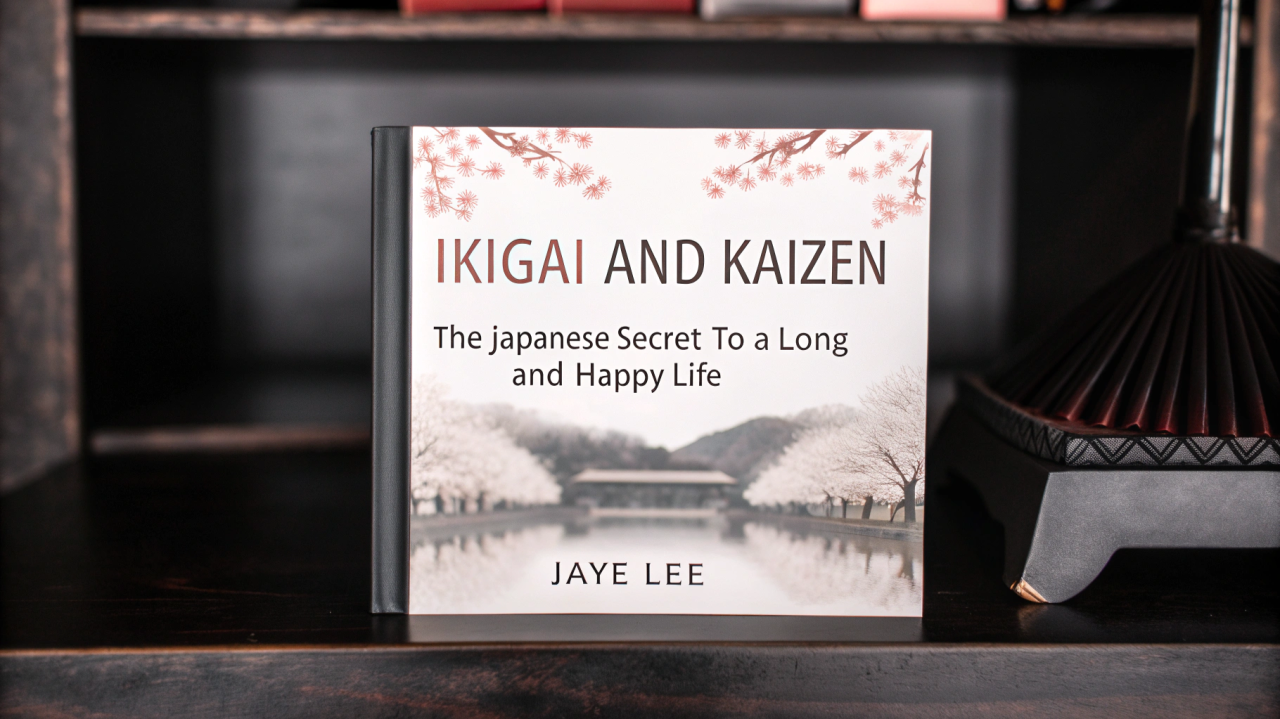
How Ancient Japanese Wisdom Transformed My Approach to Business Strategy and Purpose-Driven Entrepreneurship

Jaye Lee
Business Strategist for Therapists & Coaches | ICF PCC | Scaled 3 Startups | Certified Mentor Coach & Supervisor | CEO Whisperer for the Helping Professions
I was sitting at my desk late one night, staring at another spreadsheet, when it hit me. Despite all the “success” I had on paper, something felt… empty. The business I’d built checked all the boxes everyone told me mattered, but I was exhausted and, honestly, a little lost.
That’s when I first picked up “Ikigai and Kaizen: The Japanese Secret to a Long and Happy Life” by Hector Garcia and Francesc Miralles. I wasn’t looking for business advice – I was searching for something deeper. What I found changed everything about how I approach entrepreneurship, business strategy, and leadership development.
“The most powerful business transformation doesn’t come from new tactics, but from rediscovering your center and building with intentional purpose.”
The Wake-Up Call Every Entrepreneur Needs
Most of what we see about business success is missing something huge. We’re drowning in “growth hacks” and “scaling strategies,” but nobody’s talking about building something that actually feels right in your gut.
When I talk with the helping professionals I coach at Oneness, I see the same pattern. They’re trying to squeeze themselves into business models that look good on Instagram but feel awful in reality. They’re following formulas that promise success but deliver burnout.
I’ve been there. I built that “successful” business that made me miserable. And I’ve spent years finding a better way through strategic alignment and authentic business development.
(Pro tip: If you’re struggling with entrepreneurial burnout or seeking purpose-driven business strategies, the concepts I’m about to share transformed my entire approach to business coaching.)
What Ikigai Really Means (Not What Instagram Tells You)
Here’s something that bugs me: that neat four-circle Venn diagram of Ikigai you see everywhere? It’s not even traditional Japanese wisdom. It’s a Western remix that misses a lot of the original meaning.
In Japan, Ikigai is much simpler and more profound. It’s about finding joy in living, in small moments, in being useful to others. It’s not primarily about making money at all.
But here’s where it gets interesting for us entrepreneurs. When we blend the Western and Eastern understandings, we get something powerful: a business built at the intersection of:
- What makes your heart sing
- What you’re naturally amazing at
- What people actually need
- What people will gladly pay for
When I work with clients now, we start here – not with marketing funnels or content plans. Because when you build from this center, everything else falls into place more naturally.
My Messy Journey to Finding My Center
Can I tell you something I don’t share often? My first “successful” business in a Dental Clinic nearly broke me.
From the outside, everything looked perfect. Six figures monthly, growing client list, a waiting list of 3 months for appointments, and industry recognition. But I dreaded every morning. I felt like I was playing a role in someone else’s business story.
Finding Ikigai wasn’t a lightning bolt moment for me. It was a slow dawning realization that I’d built something that wasn’t really mine. The pivot to what eventually became Oneness several years later wasn’t clean or Instagram-worthy. It was messy, scary, and full of doubt.
I kept asking myself: “What if I build something true instead of just profitable? What if I centered my business on what lights me up AND serves others deeply?”
Those questions changed everything.
Why Small Steps Beat Grand Plans Every Time: The Kaizen Business Strategy
The second Japanese concept that transformed my approach was Kaizen – the practice of small, continuous improvements that actually deliver sustainable business growth.
I used to be the queen of grand plans and massive launches. I’d work myself to exhaustion preparing for the “next big thing” that would change everything. Sound familiar to other entrepreneurs?
Kaizen flipped this on its head. Instead of betting everything on big swings, what if I got 1% better each day? What if my clients did the same? This approach to strategic business development creates compounding results over time.
I started small:
- Tweaking one question in my client intake process
- Improving one slide in my presentations
- Spending 15 minutes every day learning one new concept in digital marketing
None of these felt significant in the moment. But compound them over months? The transformation was stunning.
One of my clients, a therapist who was overwhelmed with the idea of building a practice, used this approach. Instead of creating an entire marketing strategy overnight, she committed to one small outreach action per week. 5 months later, she had a waiting list without ever feeling overwhelmed by the process.
The compounding effect of small improvements in business strategy often outperforms massive action plans that lead to burnout.
When LinkedIn Wisdom Isn’t Really Wisdom
Let’s talk about something that bothers me. The stuff that gets the most attention on LinkedIn is often the least helpful in real life.
The “I built a 7-figure business in 90 days” posts get all the engagement while the nuanced, honest conversations about building something meaningful get buried.
I notice how I sometimes feel the pull to create content that will perform well rather than content that will actually help. It’s a tension I live with every day.
Here’s what I’ve decided: I’d rather reach fewer people with something real than reach thousands with empty calories. I’d rather be known for depth than for viral posts.
That’s a tricky stance for a thought leader, I know. But it’s the only one that lets me sleep at night.
How This Works in Real Life
I want to get practical here. How do you actually apply Ikigai and Kaizen when you’re trying to build or grow a business in the helping professions?
Here’s what it looks like with my clients at Oneness:
First, we get honest about alignment:
- Which clients make you feel energized after calls?
- What services do you offer that feel like they flow naturally?
- When do you lose track of time because you’re so in the zone?
- What problems do you solve that people thank you profusely for?
This isn’t fluffy stuff. It’s critical business intelligence. Because when you build from this center, marketing becomes easier, sales become more natural, and referrals start flowing.
Then, we pick ONE small thing to improve each week:
- Maybe it’s sending a better welcome email
- Perhaps it’s making your scheduling process smoother
- It could be refining how you explain your most popular service
- Or simply improving how you start your client sessions
One client, a self-employed Physiotherapist with staff, focused on making her onboarding just a little better each month. 4 months later, she had cut 6 hours of administrative hassle from her week – time she used to serve more clients and develop new offerings.
The Surprising Truth About Profitable Businesses
Here’s what nobody told me when I started out:
The businesses that make the most money aren’t usually the ones obsessed with making money.
The most profitable businesses I see are built by people who are deeply aligned with their work. They solve problems they genuinely care about. They serve people they authentically connect with. They offer services that energize rather than drain them.
When you build from this place:
- You don’t have to “sell” as hard because your passion about what you do is contagious
- People refer others to you without being asked
- You can charge premium rates because your alignment creates exceptional value
- You have the energy to keep going when challenges arise
My highest-earning clients at Oneness aren’t following complex funnel strategies or aggressive marketing tactics. They’re simply showing up fully as themselves, solving problems they care about, and continuously making their work a little better.
Moving Beyond the Book Into Daily Practice
Garcia and Miralles give us a wonderful introduction to these concepts in their book, but the real transformation happens when you bring them into your daily business practices.
At Oneness, we’ve created simple frameworks to make this practical:
- Start your week by asking: “What small improvement would make the biggest difference this week?”
- End your day by reflecting: “What part of today’s work felt most aligned?”
- Before creating a new offering, check: “Does this sit in my Ikigai sweet spot?”
- When feeling overwhelmed, ask: “What 1% step can I take right now?”
These aren’t complicated strategies. They’re human-sized questions that keep us centered on what matters.
The Courage to Choose Your Own Path: Strategic Business Leadership
Building a business this way takes real courage and authentic leadership. While everyone else is chasing quick wins and overnight success stories, you’re committing to alignment and gradual improvement – a counterintuitive but powerful business strategy.
It can feel slow sometimes. It can feel like you’re missing out on the next big thing. Trust me, I know those feelings well as a business strategist and coach.
But here’s what I’ve learned from my own entrepreneurial journey and from guiding many others through business transformation: The slow path is actually the fast path. When you build from genuine alignment and improve continuously, you create something sustainable that grows almost organically.
The helping professionals who will thrive in the coming years aren’t those who master every marketing trend. They’re those who build businesses that reflect who they truly are, solve problems they deeply care about, and get a little better every single day.
Key Business Strategy Takeaways:
- Authentic alignment creates magnetic client attraction
- Continuous improvement compounds into transformative results
- Purpose-driven businesses naturally outperform profit-first models
- Strategic patience yields greater long-term growth than tactical urgency
“The most sustainable competitive advantage comes from building a business that’s uniquely aligned with your authentic strengths and values.”
What Really Matters in the End: Purpose-Driven Business Development
The elders of Okinawa who inspired the book on Ikigai have something profound to teach us entrepreneurs and business leaders. At the end of our lives, we won’t measure success by followers, revenue, or even impact metrics. We’ll measure it by whether our work reflected who we truly are and contributed something meaningful.
Your business can be both profitable AND purposeful. Not through grand vision boards and aggressive growth targets, but through the quiet power of alignment and small, consistent improvements – the core principles of effective business strategy.
This isn’t just philosophical musing – it’s the most practical business advice I can offer after years of doing it wrong and finally finding a better way through strategic business development and authentic leadership.
I’d love to hear where you are on this journey. Are you building something that looks impressive, or something that feels right? The space between those two is where the most important strategic business decisions happen.
🔑 Question for reflection: What one small improvement could you make this week that would bring your business into greater alignment with your strengths and values?
Leave a comment below or DM me if you’d like to explore how these Japanese principles could transform your approach to business strategy and purpose-driven entrepreneurship.
About me:
As a business strategist and ICF PCC coach at Oneness, I help coaches, therapists, and other helping professionals build businesses that are both deeply fulfilling and commercially successful. My approach blends strategic clarity with authentic alignment – because I believe the best businesses grow from who you truly are. Connect with me to explore business transformation strategies that feel right AND deliver results.
#BusinessStrategy #BusinessCoaching #EntrepreneurialSuccess #BusinessTransformation

0 Comments